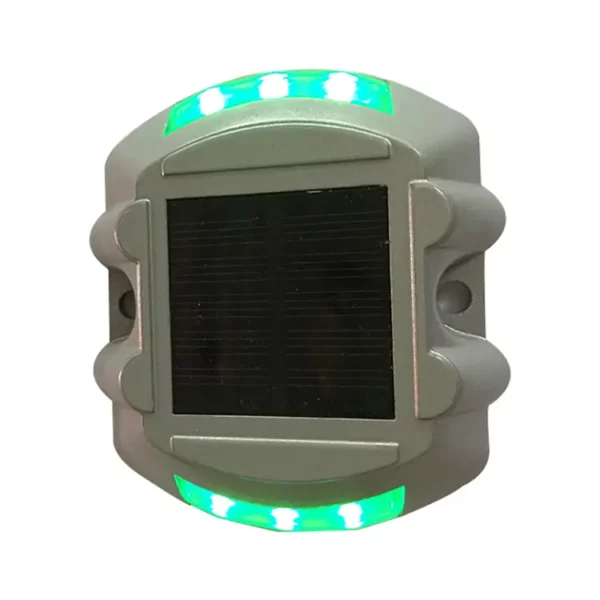The installation and maintenance of solar road studs are critical to ensuring their proper functionality and longevity.
Here are the key steps involved:
Installation:
- Site Assessment: Before installation, conduct a site assessment to determine the locations where solar road studs should be placed. Consider factors like road geometry, visibility requirements, and traffic patterns.
- Clean the Surface: Ensure that the road surface is clean and free of debris, dirt, and standing water. Proper adhesion is essential for the studs to function effectively.
- Drilling Holes: For stud placement, holes are typically drilled into the road surface. The size and depth of the holes should match the specifications provided by the manufacturer.
- Stud Placement: Insert the solar road studs into the pre-drilled holes, ensuring that they are level with the road surface. They should be securely fixed in place.
- Sealing: Seal the area around the studs to prevent water infiltration. Proper sealing is crucial for the long-term performance of the studs. Sealant should be durable and weather-resistant.
- Wiring: Connect the wiring of the solar road studs. The wiring should be done according to the manufacturer’s instructions and local electrical codes. The studs typically have a solar panel, LED lights, and a battery.
- Testing: After installation, test the studs to ensure that the LED lights are functioning correctly. This can be done using natural or artificial light to verify that the studs charge during the day and illuminate at night.
Maintenance:
- Regular Cleaning: Solar road studs should be cleaned regularly to ensure that the solar panels remain efficient in capturing sunlight. Remove dirt, solar road stud debris, and any obstructions that may hinder the solar charging process.
- Battery Maintenance: Check the condition of the batteries periodically. Replace worn-out or damaged batteries as needed. Properly functioning batteries are essential for storing and providing power to the LEDs at night.
- LED Inspection: Inspect the LED lights for any signs of malfunction or damage. Replace any faulty LEDs promptly to maintain visibility and safety.
- Sealant Inspection: Regularly inspect the sealant around the studs. Look for cracks, gaps, or signs of wear. Reapply sealant as necessary to prevent water penetration, which can damage the internal components.
- Wiring and Connections: Ensure that the wiring and electrical connections remain secure. Loose or damaged connections can disrupt the functionality of the solar road studs. Address any issues promptly.
- Cleaning the Lens: The lens or cover of the road studs should be kept clean and clear. Dirt or scratches on the lens can diminish the effectiveness of the LED lights. Clean and replace the lens as needed.
- Replacement: Over time, solar road studs may wear out due to heavy traffic, harsh weather, or accidents. When studs become damaged or reach the end of their lifespan, they should be replaced to maintain road safety.
Proper installation and regular maintenance are essential for ensuring that solar road studs remain functional and contribute to road safety. Regular inspections and prompt repairs or replacements are key to their long-term effectiveness.
What are the environmental benefits of using solar road studs?
The use of solar road studs offers several environmental benefits, contributing to sustainability and reducing the environmental impact of transportation infrastructure. Here are some of the key environmental advantages:
- Reduced Energy Consumption: Solar road studs operate primarily on renewable solar energy, which reduces the reliance on traditional energy sources. This results in decreased energy consumption and a lower carbon footprint.
- Minimal Light Pollution: Solar road studs are designed to emit directed and controlled light, which minimizes light pollution. Unlike traditional streetlights, which can scatter light in all directions, solar road studs focus their illumination on the roadway, reducing wasted light that can disturb natural habitats and the night sky.
- Lower Greenhouse Gas Emissions: By reducing the energy demand for roadway lighting, solar road studs help lower greenhouse gas emissions associated with electricity generation. This contributes to efforts to combat climate change.
- Sustainable Infrastructure: The use of solar road studs promotes sustainable infrastructure development. By incorporating renewable energy technology into roads, transportation networks become more environmentally responsible and contribute to the transition to cleaner energy sources.
- Energy Efficiency: Solar road studs are energy-efficient devices. They harness solar power during the day and use it for illumination at night, effectively converting sunlight into light energy without wasting excess power.
- Reduction in Light Trespass: Solar road studs are specifically designed to emit light only where it is needed—on the road. This reduces light trespass into surrounding areas and ecosystems, preserving the natural environment and the behavior of nocturnal animals.
- Resource Conservation: The use of solar road studs minimizes the need for energy-intensive, grid-connected lighting solutions. This helps conserve natural resources and reduces the environmental impact associated with manufacturing, transportation, and installation of traditional lighting infrastructure.
- Enhanced Safety and Wildlife Protection: By providing well-lit road markings and traffic guidance, solar road studs improve road safety. This, in turn, reduces the likelihood of accidents and injuries to both humans and wildlife on or near roadways.
- Less Light Clutter: Solar road studs contribute to a cleaner and less cluttered visual landscape. They eliminate the need for an excessive number of traditional road signs, lights, and reflectors, making roadways more aesthetically pleasing and ecologically friendly.
- Reduced Maintenance Needs: Solar road studs require minimal maintenance compared to traditional roadway lighting systems. This results in reduced maintenance vehicle traffic, fuel consumption, and associated emissions, contributing to a greener transportation network.
Overall, the use of solar road studs aligns with sustainable and environmentally responsible practices. They help conserve energy, minimize light pollution, and reduce the environmental impact of transportation infrastructure, all while enhancing road safety.

